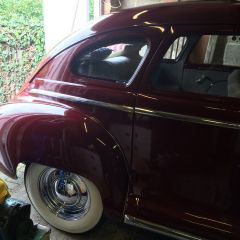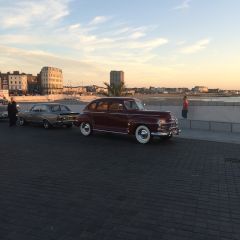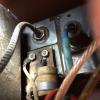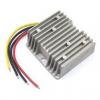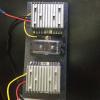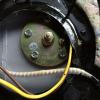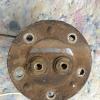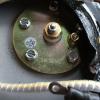-
Posts
155 -
Joined
-
Last visited
Content Type
Links Directory
Profiles
Articles
Forums
Downloads
Store
Gallery
Blogs
Events
Everything posted by Seaside Pete
-

Generator to alternator conversion 56 coronet 230 flathead 6
Seaside Pete replied to lgk596's topic in P15-D24 Forum
Can you still use the ammeter with an alternator? somebody told me that you have to change it either to a red warning light, or a voltmeter, is this true as I would rather use the ammeter that's in my P15. Thanks -
Thanks guy', great help as always Pete
-
Hi I am looking for some front door stays for my P15 4Dr (not sure if that's the right description) but the bars that stop the front doors opening too far, as mine are missing. I can't seem to find any, or pics of them. Could anybody help with a picture of what they should look like and some dimensions would be great, and maybe I could fabricate some. Thanks in advance. Pete
-
From the album: 1947 P15
-
From the album: 1947 P15
-
From the album: 1947 P15
-
My P15 normally runs at about 160 but I was having smooth running problems, found out that the vacuum advance diaphragm had gone so I have removed it and waiting for delivery of a new one. In the meantime as a temporary measure I have advanced the timing to max to compensate, the temp gauge is reading higher but still runs at about 180, so not sure if a timing issue could cause the problem?
- 30 replies
-
I Have had quite a few parts shipped over to the UK from AB on a few occasions and never had a problem. Always seemed very helpful and good communications.
-
Sorry to hear about your problems Don, it's amazing to hear how many of us oldies on here suffer with type 2 (me included) Wishing you the best from here in the UK. Pete
-
I agree. Generally when it comes to wheels/tires/discs/brake drums etc, if you feel a steering wheel wobble it's the front no steering wheel but foot pedal it's the rear. Pete
-
Hi Skrambler. Do you want to sell one of those clocks you have? Thanks Pete
-
-
Maybe a silly question but, what is the "POC" facebook page? Pete
-
Ah! it would appear there are 2 types then mine is like Dodgeb4ya whereas RedBay's does not have the bottom left connector. At least I know my gauge is connected right. Thanks for the pics DodgeB Pete
-
Although I have covered this subject before, I notice in your last picture that the live feed on your gauge goes to the center nut/terminal, whereas mine goes to the bottom left nut/terminal so which one is correct? this may be your problem or indeed my problem. When I purchased my new tank and sender from tanks inc they listed a single pole sender not a 2 pole sender with a 10 - 73 resistance. After contacting them to check if this was correct they confirmed yes a 10 - 73 is correct for all mopars of this age. I have a 47 P15. I have attached a pic of the back of my gauge and although you cannot see it clearly the live feed goes to the bottom left nut, I am though going to use a 12v to 6v converter that will handle up to 10 amps. Any advice would be helpful. Pete
-
I purchased these for my P15. They came with small screws. I am yet to fit them but, as they are supplied I can only assume they will work. Pete
-
How do you adjust the voltage regulator? I didn't know you could do that. What is the advantage of adjusting, does it give a higher charge rate?
-
Hi Guys I am about to fit a pair of backup/reversing lights to my 47 P15. My question is as the bulbs will be about 21 watts each will I need a relay or can the switch handle that amount of draw? (I have attached a pic of the switch I am using) because I only have room on the fuseboard that I have made for 1 more relay and I know I will need one for a pair of spotlamps that I intend to fit, or perhaps I should use LED bulbs as they don't draw as much power. Thanks in advance. Pete
-

Finally.... Some photos of my 52 Dodge Coronet
Seaside Pete replied to Bobandy's topic in P15-D24 Forum
Nice car, congrats Pete -
Hi Welcome to the forum. Yet another UK member. Where in the UK are you? I am in Kent. Pete
-
Hi Earl Still using a generator not an Alternator. Pete
-
I have made up a small board that fits under the dash which has 2 x 6-12v converters and fuse bank fitted. I used 2 converters because they handle max 10 amps and I need to convert for my radio and heater fan as well. Calibrating the sender could be difficult as the sender fitted in the tank does not line up with the hole in the floor (as can be seen in one of my previous pics), so I would have to drop the tank again. .
-
I bought a new tank and sender from "tank's inc" for my P15. It cost $230, it looked good quality. It fitted ok but the sender didn't line up with the hole in the floor although that wasn't much of a problem. However I am having trouble with getting the gauge to work, at first I thought my gauge was at fault so searched for quite a while to find another. I found a replacement but had the same problem. I had a friend of mine take a look and on closer inspection we noticed that although the new sender had 2 terminals, unlike the OE one which both terminals were insulated the new one had only one was insulated so the other must have been an earth. Thinking that tank's inc had sent the wrong sender I contacted them and got this reply Hi Peter, Thank you for your email, you did get the correct sender IF you have the original fuel gauge for your Dodge/Plymouth. The universal sender has a positive (which is the middle Terminal and a negative which is the terminal to the side). You must ground the sender to your frame in order to get the correct OHMs, since it is ground to resistance that will allow it to work correctly. If you have 2 terminals on your gauge, try just connecting one and if that doesn’t work, move it to the other one. You will only need one connected. I forgot to mention to them that the car had been converted to 12v NEG earth so emailed them again and got the reply The Voltage doesn’t matter, it is ground to resistance, HOWEVER, the center terminal should hook to your fuel gauge’s signal terminal and the off center terminal to a good chassis ground. I have not yet had time to try out what they have said but, would appreciate any comments. Thanks in advance. Pete
-
Hi Saran (plastic)From Wikipedia, the free encyclopedia Saran is the trade name for a number of polymers made from vinylidene chloride (especially polyvinylidene chloride or PVDC), along with other monomers. Since its accidental discovery in 1933, Saran has been used for a number of commercial and industrial products. When formed into a thin plastic film, the principal advantage of Saran, when compared to other plastics, is its very low permeability to water vapor, flavor and aroma molecules, and oxygen. This oxygen barrier retards food spoilage, while the film barrier to flavor and aroma molecules helps food retain its flavor and aroma. Contents 1 History 2 Trademark status 3 References 4 External links HistorySee also: Polyvinylidene chloride Polyvinylidene chloride (PVdC) was discovered at Dow Chemical Company (Michigan, USA) in 1933 when a lab worker, Ralph Wiley, was having trouble washing beakers used in his process of developing a dry-cleaning product. It was initially developed into a spray that was used on US fighter planes and, later, automobile upholstery, to protect them from the elements. Dow Chemical later named the product Saran, and eliminated its green hue and offensive odor. In 1942, fused layers of original-specification Saran or PVDC were used to make woven mesh ventilating insoles for newly developed jungle or tropical combat boots made of rubber and canvas.[1][2][3] These insoles were tested by experimental Army units in jungle exercises in Panama, Venezuela, and other countries, where they were found to increase the flow of dry outside air to the insole and base of the foot, reducing blisters and tropical ulcers.[2][3] The Saran ventilating mesh insole was later adopted by the United States Army for standard issue in its M-1945 and M-1966 Jungle Boots.[1][2] In 1943, John Reilly (Ralph Wiley's boss)[4] and Ralph Wiley of The Dow Chemical Co. completed the final work needed for introduction of Saran (polyvinylidene chloride), which had been invented in 1939.[5] Saran monofilaments were also extruded for the first time.[6] The word "Saran" was coined by a combination of John Reilly's wife's and daughter's names, Sarah and Ann Reilly.[7] In 1949, Dow introduced Saran Wrap, a thin, clingy plastic wrap that was sold in rolls and used primarily for wrapping food. It quickly became popular for preserving food items stored in the refrigerator. Saran Wrap was later acquired by S. C. Johnson & Son. However, today's Saran Wrap is no longer composed of PVDC, supposedly due to environmental concerns with halogenated materials, and is now made from ordinary polyethylene.[8] However, polyethylene has a higher oxygen permeability, which in turn affects food spoilage prevention. For example, at 23 °C and 95% relative humidity polyvinylidene chloride has an oxygen permeability of 0.6 cm3 μm m−2 d−1 kPa−1 while low-density polyethylene under the same conditions has an oxygen permeability of 2000 cm3 μm m−2 d−1 kPa−1.[9] After the end of the Vietnam War, the U.S. military phased out Saran insoles in favor of Poron®, a microcellular urethane, for its jungle and combat boots.[2] However, the British Army continues to use Saran insoles in its combat boots, primarily because of its insulating properties.[10]
-
Wishing you all a very Merry Christmas. Thank you all for the help during 2015 and hope I don't need so much in 2016. Pete



